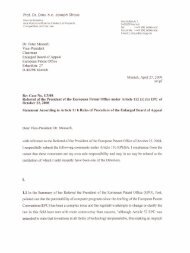Assessing the Obstacles to Industrialisation: The ... - Innovation
Assessing the Obstacles to Industrialisation: The ... - Innovation
Assessing the Obstacles to Industrialisation: The ... - Innovation
You also want an ePaper? Increase the reach of your titles
YUMPU automatically turns print PDFs into web optimized ePapers that Google loves.
<strong>Industrialisation</strong> in Mexicoaffluent, which possessed large and well-integrated markets, and whichhad <strong>the</strong> ability <strong>to</strong> accumulate and mobilise <strong>the</strong> capital <strong>to</strong> financemanufacturing-ventures were <strong>the</strong> economies which were <strong>the</strong> first <strong>to</strong>industrialise. Scholars have emphasised that no single feature or institutioncan be isolated as <strong>the</strong> determinant in industrial success, but <strong>the</strong>y wouldagree that <strong>the</strong> lack of <strong>the</strong>se features as a group would certainly workagainst successful industrialisation. It just so happens that from <strong>the</strong> 1830s<strong>to</strong> <strong>the</strong> 1880s almost all of <strong>the</strong> features which permitted industrial growth<strong>to</strong> occur rapidly in <strong>the</strong> Western European and US settings were lackingin Mexico.First and foremost, those countries which underwent successfulprocesses of industrialisation were already relatively affluent. <strong>The</strong>y hadrealised slow rates of growth in per capita income for a number of decadeswell before <strong>the</strong>y began <strong>to</strong> industrialise, and attained quite high levels ofnational income for pre-industrial societies. <strong>The</strong> Mexican economy, on <strong>the</strong>o<strong>the</strong>r hand, was not only significantly smaller than <strong>the</strong> successfulindustrialisers, it was also shrinking - both absolutely and relatively. In1800, according <strong>to</strong> John Coatsworth's estimates, Mexico's per capitaGDP (in I 9 j o US dollars) was $73, roughly two-fifths that of <strong>the</strong> UnitedStates and Great Britain. Throughout <strong>the</strong> first half of <strong>the</strong> nineteenthcentury, per capita GDP actually declined, falling <strong>to</strong> $j 6 per capita in I 845and $49 in 1860. In this last year it was only I 3 O/O of British per capitaGDP and 14 % of <strong>the</strong> US figure. It was not until <strong>the</strong> I 860s that per capitaGDP began <strong>to</strong> increase, rising <strong>to</strong> $62 in 1877 and <strong>to</strong> $91 in 18~~.'Underlying this fall in national income were a number of fac<strong>to</strong>rs, all ofwhich we may also specify as obstacles <strong>to</strong> industrialisation. It should bekept in mind, however, that <strong>the</strong>se were impediments not only <strong>to</strong> industrialgrowth, but <strong>to</strong> economic growth in general. Let us take up each of <strong>the</strong>sein detail.Perhaps <strong>the</strong> most noticeable obstacle <strong>to</strong> Mexican industrialisation was<strong>the</strong> lack of a national market because of high transport costs. Unlike <strong>the</strong>United States, England or <strong>the</strong> o<strong>the</strong>r early industrialisers, whose regionswere connected by low-cost transport systems (canal and riverine traffic,coastal shipping, and <strong>to</strong>ll roads), Mexico's <strong>to</strong>pography prevented <strong>the</strong>development of inexpensive modes of transport. Only one-third of <strong>the</strong>land mass of <strong>the</strong> country is reasonably level, and <strong>the</strong>re aie almost nonavigable waterways, save for a few rivers in <strong>the</strong> sparsely populatedsou<strong>the</strong>astern states of Veracruz and Tabasco. In addition, <strong>the</strong> greatmajority of <strong>the</strong> population has his<strong>to</strong>rically lived in <strong>the</strong> mountainousinterior of <strong>the</strong> country, meaning that coastal traffic could not play asignificant role in linking markets.John H. Coatsworth, '<strong>Obstacles</strong> <strong>to</strong> Economtc Growth in Nineteenth Century Mextco',Anlerican His<strong>to</strong>rical Review, vol. 83 (1978), p. 82.3





